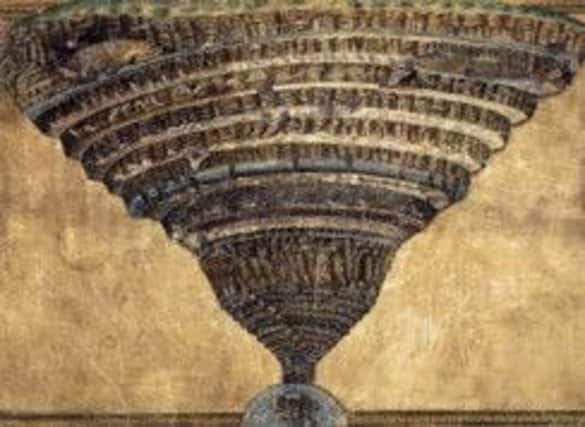Book review: Inferno by Dan Brown


Inferno
Dan Brown
Bantam Press, £25
She looks like trouble in more ways than one. What is the girl with the dragon tattoo doing in Dan Brown’s new book?
She’s scaring Robert Langdon, the tweedy symbologist who stars in Brown’s breakneck, brain-teasing capers. Reader, she will scare you too. The early sections of Inferno come so close to self-parody that Brown seems to have lost his bearings – as has Langdon, who begins the book in a hospital bed with a case of amnesia.
Advertisement
Hide AdBut the novel is jam-packed with tricks, and that shaky opening turns out to be one of them. There are games with time, gender, identity, famous tourist attractions and futuristic medicine – plus the bit with the symmetrical, clockwise, Archimedean spiral, which will have people slowly rotating their copies of the novel trying not to look silly as they scrutinize the rounded calligraphy on Page 255.
It begins with Langdon’s being wakened by a beautiful, ponytailed Doctor Sienna in order to race through Florence, trying to figure out what a cylinder hidden inside a titanium tube with a biometric seal and a biohazard symbol is telling him.
It’s a tiny projector that offers a scrambled version of a Botticelli image, La Mappa Dell’Inferno. And that sends Langdon and Sienna off to the races, engaging in one of those book-length scavenger hunts that Brown creates so energetically. There’s an awful lot of touristy detail, and Langdon will always choose a big word over a small one, but he makes a passable tour guide and art critic throughout.
But it takes more than geography to keep a Brown escapade spinning. The formula also calls for sinister cultism of some sort, and in this case the dark scheming involves overpopulation. One character, Zobrist, is a wealthy Malthusian with a powerful, secretive, hi-tech army at his command (Brown insists it is real, but he has given it “the Consortium” as a fake name) and a doomsday plot to implement.
There’s a lot more in Inferno along these lines. And it all ties together. Dante’s nightmare vision becomes the book’s visual correlative for what its scientific calculations suggest. And eventually the book involves itself with Transhumanism, genetic manipulation and the potential for pandemics. Just as Brown’s Lost Symbol tried to stir interest in the noetic sciences (studying mind-body connections), Inferno puts the idea of a plague front and centre, invoking the Black Death, its casualty count and its culling effect on mankind. Brown is more serious than usual when he invokes Dante’s dire warning: “The darkest places in hell are reserved for those who maintain their neutrality in times of moral crisis.”
But the main emphasis here is hardly on gloom. It is on the prodigious research and love of trivia that inform Brown’s stories (this one makes mincemeat of all those factoid-heavy wannabes, like Matthew Pearl’s Dante Club), the ease with which he sets them in motion, the nifty tricks (Dante’s plaster death mask is pilfered from its museum setting, then toted through the secret passageways of Florence in a Ziploc bag) and the cliffhangers. (Sienna: “Don’t tell me we’re in the wrong museum.” Robert: “Sienna, we’re in the wrong country.”) There is the gamesmanship that goes with crypto-bits like “PPPPPPP”. (Sienna: “Seven Ps is… a message?” Robert, grinning: “It is. And if you’ve studied Dante, it’s a very clear one.”)
Advertisement
Hide AdAnd finally there is the sense of play that saves Brown’s books from ponderousness, even when he is waxing wise about some ancient mystery or architectural wonder. Once the globe-trotting begins in earnest, private planes figure in the story and Langdon calls his publisher to ask for one. No, says the publisher, then adds: “Let me rephrase that. We don’t have access to private jets for authors of tomes about religious history. If you want to write Fifty Shades Of Iconography, we can talk.”
Brown, though, has already written it. «